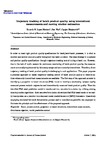Trajectory tracking of batch product quality using intermittent measurements and moving window estimation
| dc.contributor.author | Lopez-Montero, EB | |
| dc.contributor.author | Wan, Jian | |
| dc.contributor.author | Marjanovic, O | |
| dc.date.accessioned | 2015-10-23T09:21:15Z | |
| dc.date.available | 2015-10-23T09:21:15Z | |
| dc.date.issued | 2015-01 | |
| dc.identifier.issn | 0959-1524 | |
| dc.identifier.issn | 1873-2771 | |
| dc.identifier.uri | http://hdl.handle.net/10026.1/3694 | |
| dc.description.abstract |
In order to meet tight product quality specifications for batch/semi-batch processes, it is vital to monitor and control product quality throughout the batch duration. The ideal strategy is to achieve end-product quality specifications through trajectory tracking control during a batch run. However, due to the lack of in situ sensors for continuous monitoring of batch product quality, the measurements are usually implemented by laboratory assays and are inherently intermittent. Therefore, direct trajectory tracking of batch product quality is challenging in such applications. This paper proposes a practical approach to realise trajectory tracking control of batch product quality in those situations where only intermittent measurements are available. The first step of the approach consists in identifying a projection to latent structures (PLS) model to identify a relationship between readily measured process variable trajectories and intermittently measured batch product quality. Then the identified PLS-based prediction model is transformed into recursive formulation by utilising missing data imputation algorithms. Such recursive formulation allows identified PLS-based model to be readily incorporated as a predictor into standard model predictive control (MPC) framework. Case study employing simulated fed-batch fermentation process used to manufacture penicillin was employed to illustrate the principle and the effectiveness of the proposed approach. | |
| dc.format.extent | 115-128 | |
| dc.language | en | |
| dc.language.iso | en | |
| dc.publisher | Elsevier BV | |
| dc.subject | Batch process control | |
| dc.subject | Projection to latent structures | |
| dc.subject | Intermittent measurements | |
| dc.subject | Disturbance rejection | |
| dc.subject | Model predictive control | |
| dc.title | Trajectory tracking of batch product quality using intermittent measurements and moving window estimation | |
| dc.type | journal-article | |
| dc.type | JOUR | |
| plymouth.author-url | http://www.sciencedirect.com/science/article/pii/S0959152414002935 | |
| plymouth.issue | 0 | |
| plymouth.volume | 25 | |
| plymouth.publication-status | Published | |
| plymouth.journal | Journal of Process Control | |
| dc.identifier.doi | 10.1016/j.jprocont.2014.11.009 | |
| plymouth.organisational-group | /Plymouth | |
| plymouth.organisational-group | /Plymouth/Faculty of Science and Engineering | |
| plymouth.organisational-group | /Plymouth/Faculty of Science and Engineering/School of Engineering, Computing and Mathematics | |
| plymouth.organisational-group | /Plymouth/Users by role | |
| plymouth.organisational-group | /Plymouth/Users by role/Academics | |
| plymouth.organisational-group | /Plymouth/Users by role/Researchers in ResearchFish submission | |
| dc.identifier.eissn | 1873-2771 | |
| dc.rights.embargoperiod | Not known | |
| rioxxterms.versionofrecord | 10.1016/j.jprocont.2014.11.009 | |
| rioxxterms.licenseref.uri | http://www.rioxx.net/licenses/all-rights-reserved | |
| rioxxterms.type | Journal Article/Review |


